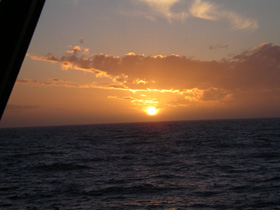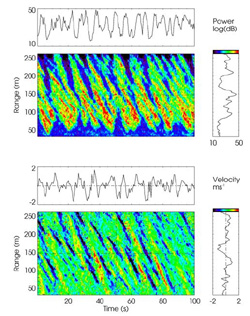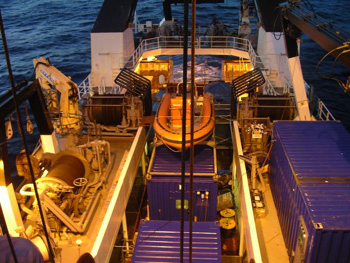Cruise
Log: Saturday, April 3, 2004
|
March
|
|
Sun
|
Mon
|
Tue
|
Wed
|
Thu
|
Fri
|
Sat
|
|
|
1
|
2
|
3
|
4
|
5
|
6
|
|
7
|
8
|
9
|
10
|
11
|
12
|
13
|
|
14
|
15
|
16
|
17
|
18
|
19
|
|
|
|
|
|
|
|
|
|
|
|
|
|
|
|
|
|
|
April
|
|
|
|
|
|
|
|
3
|
|
|
|
|
|
|
|
|
|
|
|
|
|
|
16
|
17
|
|
18
|
19
|
20
|
21
|
22
|
23
|
24
|
|
25
|
26
|
27
|
28
|
29
|
30
|
|
|
| |
 |
| Antenna
for the ocean remote-sensing radar (Photo by John McGregor). |
| |
 |
| The
obligatory sunset shot. All voyages must have at least one of these.
In our case at least it proves that we had some fine weather (Photo
by John McGregor). |
| |
 |
|
Wave
image from the radar. The upper panel shows backscattered power
from the sea surface. The lower panel shows sea surface velocity.
The slanting lines are ocean waves moving towards the ship (Credit:
John McGregor).
|
It's
on our radar
Contributor: John McGregor,
NIWA
After a night of winds
reaching 50 knots, the weather settled today, and toward evening we had
a short period with no discernible winds. There is still a 2 to 3 m swell
remaining. Today we re-infused the patch with more iron to maintain the
enhanced biological activity.
I spend most of my time
looking after the ocean remote-sensing radar. This consists of an antenna,
bolted to the starboard railing below the bridge, connected to the signal
processing electronics and associated computers in the science area. The
radar is a sophisticated instrument, one of only a few similar devices in
the world.
On this voyage, the purpose
of the radar is to measure properties of the ocean surface important in
air-sea gas exchange, specifically, the properties of ocean waves and breaking
waves. These generate turbulent mixing beneath the water surface. Breaking
ocean waves can inject clouds of bubbles into the water, and eject clouds
of droplets, in the form of spray, into the air. These processes are of
fundamental importance in determining the rate of gas transfer between the
atmosphere and the ocean. Data from the radar will be combined with data
from the foredeck mast instrumentation and Relaxed Eddy Accumulation (REA)
system (Murray, Mike, Jill and Dawn), the subsurface near-surface profilers
(Craig and Brian), and Peter's infrared radiation thermometer to build a
greatly improved picture of the physics of air-sea gas exchange.
Next
Day >>
 |
| The
Tangaroa at night (Photo by John McGregor). |
|